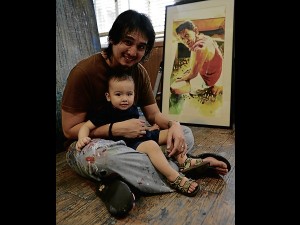 Full disclosure ahead: the artist I’m writing about is my nephew, Martin Honasan, the second son of my oldest brother Greg and his wife Jane.
Full disclosure ahead: the artist I’m writing about is my nephew, Martin Honasan, the second son of my oldest brother Greg and his wife Jane.
His first one-man show, “Digging in the Dirt,” at the Yellow Door Gallery at Rockwell, opened Oct. 8.
The show has 22 acrylic and watercolor works in a style that straddles the hyper-realism of his early years—when his family first woke up and realized that, darn, the kid can paint—and the textured abstraction he has recently discovered, just one of the many treasures he has dug for in the dirt of experimentation, and chanced upon, and is now celebrating, along with his many blessings.
And I say, it’s about time, because 35-year-old Martin has something to say, and he says it in a way that, I think, invites you to listen (or rather, look) without being pushy. You do want to look, and linger, and soak in the feelings.
Rex Kit Martin Umali Honasan has never been pushy. (All the siblings have first names starting with the letter K, but my late dad, Martin’s lolo, messed up the pattern when he insisted on Rex because his second apo was born on the Resurrection, Easter Sunday of 1976.)
I can almost hear the chorus of people in his life who will laugh at the notion of the mild-mannered Martin ever being too pushy—from his wife of five years, the singer Barbie Almalbis, to friends from their church, a good-natured gaggle of artists and musicians.
‘Masyadong mabait’
In fact, if there were words that were overused to describe Martin growing up, they would be “masyadong mabait.” That, and “shy.”
I forget now how many talent scouts and agents were on his back when he was a teenager, wooing him for this commercial or that modeling job—a prospect that only made him shudder. To this day, I have a funny feeling he still doesn’t know how cute he was, and probably will be until he turns gray.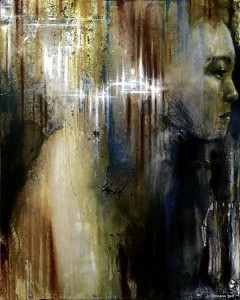
I’ve known Martin since he was a criminally cute, wide-eyed baby, when he used to drool copious amounts of saliva (which, we jokingly tell him, must explain his affinity for watercolor).
His own earliest recollection of producing artwork was at age 9 or 10, when he borrowed older brother Kim’s comics and dreamt of becoming an illustrator.
When he was in high school at Aquinas, we were all impressed when he made an excellent copy of a Jose Joya print. Then, after finishing his Interdisciplinary Studies course at the Ateneo in 1987 (his thesis was in comics form) and a short stint in advertising, he began to paint.
It was his cousin, my other nephew Garon, who invited him to join a group show in a bar with a bunch of other kids in 2002.
“I sold one work,” he recalls. I admit I was a little bemused, and thought it was something he would do on the side, a stage in a young man’s journey of discovery.
Then, wham—I remember how he floored us all, and what he floored us with. He had started taking photographs, from which he painted strikingly hyper-realist portraits of anonymous, interesting people—children in mid-leap as they jumped into the water on a sunny day, a couple riding tandem on a motorcycle in traffic.
‘Mang’ Carling
Part of the staff in Martin’s home at the time was a gangly, soft-spoken old carpenter called mang Carling, a wry fellow with sleepy eyes and a perpetual half-smile. He has since retired and, we heard, ran for a barangay post in his hometown.
Well, one day in 2005, Martin took a picture of mang Carling, towel around his neck—he indulged the boy with a half-smile, of course—and painted a truly remarkable portrait, in seemingly effortless, iridescent watercolor.
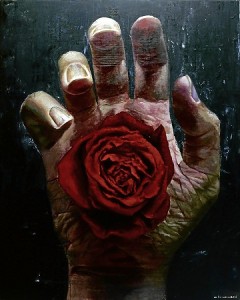 The eyes were alive and storied, the stance natural, the colors warm. I wondered, where did he learn to do that? It remains his mother Jane’s favorite piece, prominently displayed in her home.
The eyes were alive and storied, the stance natural, the colors warm. I wondered, where did he learn to do that? It remains his mother Jane’s favorite piece, prominently displayed in her home.
First real show
It was also about this time that he joined what he calls “my first real gallery group show,” titled “Nine Lives,” at the Art for Space Gallery at Alabang Town Center. Critical, I believe, to his encouragement was when he was invited to hang out with the Saturday Group.
“Not too many people can draw and paint the way they do in front of a crowd,” Martin says of what he considers the main challenge of working with the group. “It’s one thing to paint isolated in the studio. It’s a completely different story ’pag may crowd of commentators na humihinga sa balikat mo!”
He counts Saturday Group-ers Cris Cruz, Jun Rocha, Migz Villanueva, Jaime Gubaton and Carlo Ongchangco among his favorites, “mainly because my genre then, realism, was very similar to theirs. I learned a lot from these people, been through a lot with them.”
He continued to take on the volatile medium of watercolor, despite its unpredictability. Typically Martin, his main reason for using watercolor had little to do with profundity or aesthetics.
“Kasi akala ko watercolor ’yung cheapest medium dati,” he says with a laugh. “I was trying to be economical.
“Plus, watercolor is a luminous and transparent medium, since it’s rarely possible to hide the white of the paper and the strokes of a brush. The results are usually very painterly. I like painterly, it’s elegant.”
The recent shift to acrylic, he says, is because he’s had his fill of watercolor for now, and felt constricted by the small surface he could paint on. “I felt it was time to start working on more large-scale stuff, large surfaces, bigger brushes, loads of paint!”
Thus, from almost diaphanous surfaces as light as air, he’s now coming up with canvases where you can almost feel the roughness of the material under your fingers.
We’ve had discussions about abstract expressionists, such as the fiery Jackson Pollock and his “hagod,” his expansive, haphazard smearing of paint over the canvas.
“The physical act of painting was very evident. And I think most of them painted violently, flinging paint all over, with palette knives, bare hands. You can almost imagine them dancing in front of the canvas.”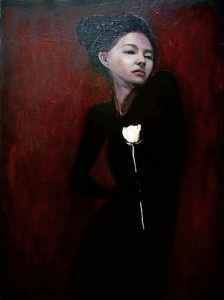
Martin hasn’t been back with his Saturday Group buddies for some time, mainly because of preparations for his show, and the time spent with his growing family.
He and Barbie now have two children: Noa Stina, an amazingly precocious little girl of 4, and 1-year-old Liam Israel, who looks quite a bit like his papa did at his age.
Agreeable disposition
When Liam giggles, I do remember his dad as a boy, all smiles and agreeable disposition—except that Liam doesn’t drool as much (I guess he’ll never become a watercolorist?).
I ask Martin a question I’ve asked many artists, and which seems nicely appropriate now. He’s happy, his family is happy —what about the angst that’s supposed to inspire creativity?
“Okay lang,” he shrugs. “Angst is an effective fuel for productivity, but it’s just one of many types of ‘emo’ to feed art. Everybody goes through different seasons of sorrow, frustration, longing, anger, joy, and art is a way of expressing and filtering all that drama, kind of like a journal.”
That’s why “Digging in the Dirt” is a cool title, because it’s about a pretty straightforward act of looking for good stuff amid the everyday, which Martin has found in his family and in his faith.
“I believe my calling as an artist is something my family must share with me, the same way we all participate in Barbie’s music. My message as an artist depends heavily on my relationships—my identity as a husband, father, son, brother or friend flows into my work. But my faith in God is the most important and overarching relationship that binds everything in my life.”
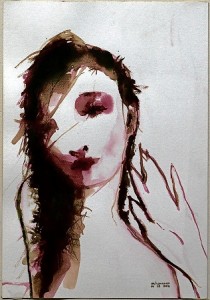 So what kind of artist does he want to be? “Angsty—loko lang! Siyempre, like almost every artist in the world, I want to be able to come up with something authentic and fresh, and get paid for it. But more than that, I want to be able to leave a body of work that will speak life to people. And I want my work to point to my life and how I shared it.”
So what kind of artist does he want to be? “Angsty—loko lang! Siyempre, like almost every artist in the world, I want to be able to come up with something authentic and fresh, and get paid for it. But more than that, I want to be able to leave a body of work that will speak life to people. And I want my work to point to my life and how I shared it.”
As family, we’ve managed to share that life—and talent—in a more permanent way. Tattooed forever on his older brother Kim’s entire back is a huge, exquisite sketch of a jumping boy by Martin, painstakingly duplicated by tattoo artist Nero Nievo.
Meanwhile, on the back of my right hand is an uncanny likeness of my late, beloved dog Banana—again, tattooed by tatay Nero from a sketch by Martin. I look at my hand, and I look into the life-like eyes of my much-missed pet every day.
Being related to an artist—and I dare say, a good one—does have its perks.
“Digging in the Dirt” runs until Oct. 23 at the Yellow Door Gallery, R1, G/F, Power Plant Mall, Rockwell, Makati.









































